2016 JEEP GRAND CHEROKEE coolant level
[x] Cancel search: coolant levelPage 11 of 117

•Fuel meets minimum requirement
• System not disabled from previous remote start event
• Vehicle security alarm not active
• Water In Fuel Indicator Light is not illuminated
• “Wait To Start” telltale is not illuminated
WARNING!
•Do not start or run an engine in a closed garage or
confined area. Exhaust gas contains Carbon Mon-
oxide (CO) which is odorless and colorless. Carbon
Monoxide is poisonous and can cause serious in-
jury or death when inhaled.
• Keep Remote Keyless Entry (RKE) transmitters
away from children. Operation of the Remote Start
System, windows, door locks or other controls
could cause serious injury or death.
ENGINE BREAK-IN RECOMMENDATIONS
The diesel engine does not require a break-in period due
to its construction. Normal operation is allowed, provid-
ing the following recommendations are followed:
• Warm up the engine before placing it under load.
• Do not operate the engine at idle for prolonged
periods.
• Use the appropriate transmission gear to prevent
engine lugging.
• Observe vehicle oil pressure and temperature indica-
tors.
• Check the coolant and oil levels frequently.
• Vary throttle position at highway speeds when carry-
ing or towing significant weight.
2
THINGS TO KNOW BEFORE STARTING YOUR VEHICLE 9
Page 16 of 117
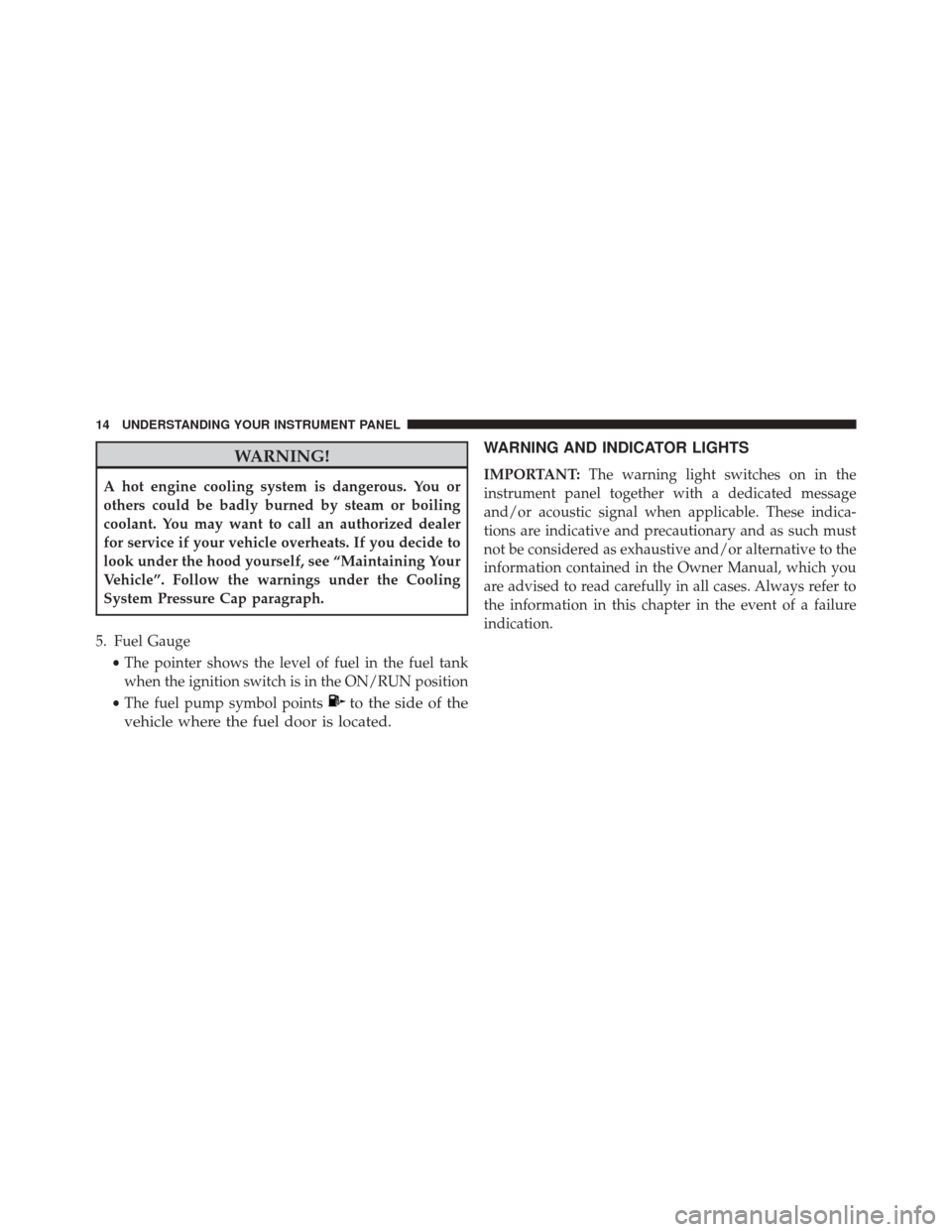
WARNING!
A hot engine cooling system is dangerous. You or
others could be badly burned by steam or boiling
coolant. You may want to call an authorized dealer
for service if your vehicle overheats. If you decide to
look under the hood yourself, see “Maintaining Your
Vehicle”. Follow the warnings under the Cooling
System Pressure Cap paragraph.
5. Fuel Gauge •The pointer shows the level of fuel in the fuel tank
when the ignition switch is in the ON/RUN position
• The fuel pump symbol points
to the side of the
vehicle where the fuel door is located. WARNING AND INDICATOR LIGHTS
IMPORTANT:
The warning light switches on in the
instrument panel together with a dedicated message
and/or acoustic signal when applicable. These indica-
tions are indicative and precautionary and as such must
not be considered as exhaustive and/or alternative to the
information contained in the Owner Manual, which you
are advised to read carefully in all cases. Always refer to
the information in this chapter in the event of a failure
indication.
14 UNDERSTANDING YOUR INSTRUMENT PANEL
Page 42 of 117
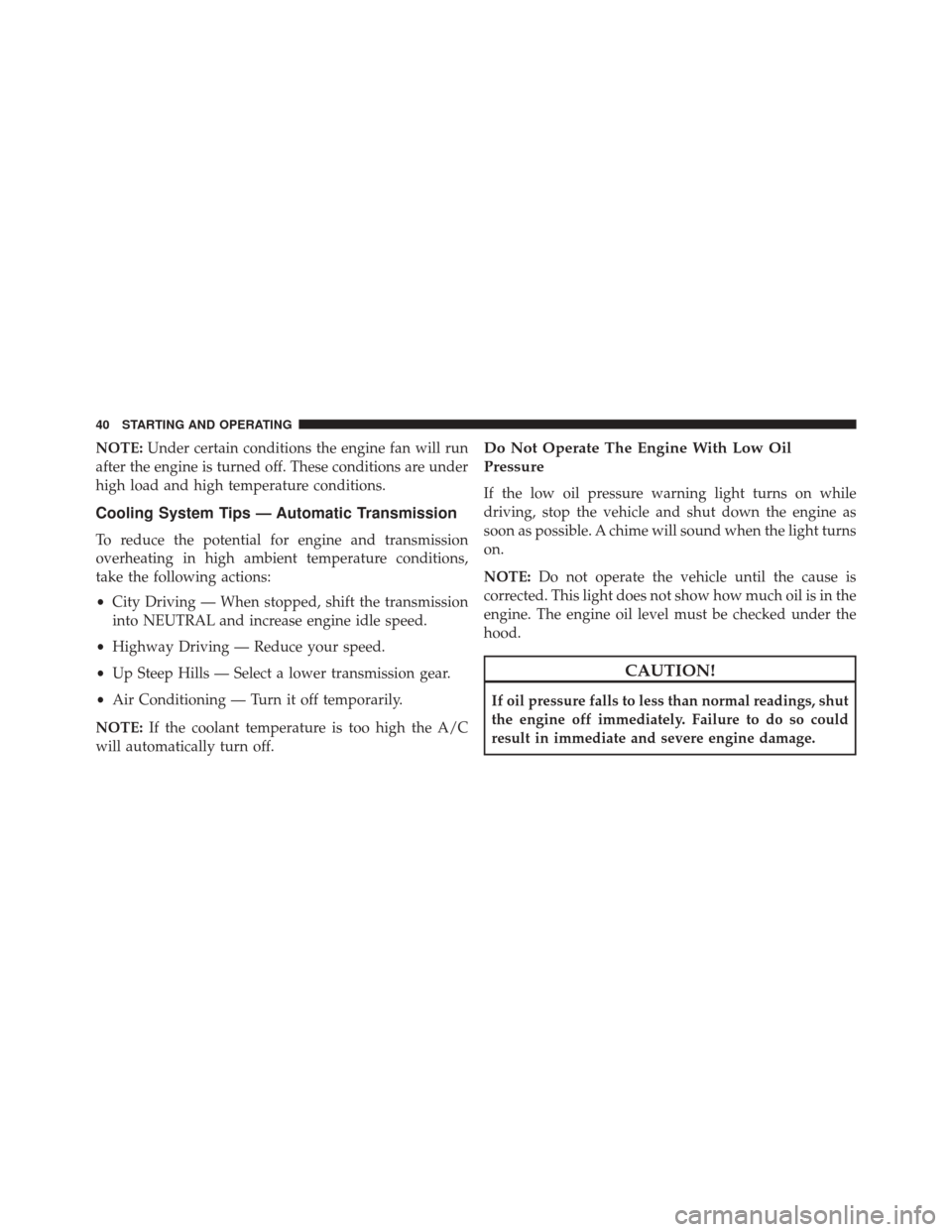
NOTE:Under certain conditions the engine fan will run
after the engine is turned off. These conditions are under
high load and high temperature conditions.
Cooling System Tips — Automatic Transmission
To reduce the potential for engine and transmission
overheating in high ambient temperature conditions,
take the following actions:
• City Driving — When stopped, shift the transmission
into NEUTRAL and increase engine idle speed.
• Highway Driving — Reduce your speed.
• Up Steep Hills — Select a lower transmission gear.
• Air Conditioning — Turn it off temporarily.
NOTE: If the coolant temperature is too high the A/C
will automatically turn off.
Do Not Operate The Engine With Low Oil
Pressure
If the low oil pressure warning light turns on while
driving, stop the vehicle and shut down the engine as
soon as possible. A chime will sound when the light turns
on.
NOTE: Do not operate the vehicle until the cause is
corrected. This light does not show how much oil is in the
engine. The engine oil level must be checked under the
hood.
CAUTION!
If oil pressure falls to less than normal readings, shut
the engine off immediately. Failure to do so could
result in immediate and severe engine damage.
40 STARTING AND OPERATING
Page 89 of 117
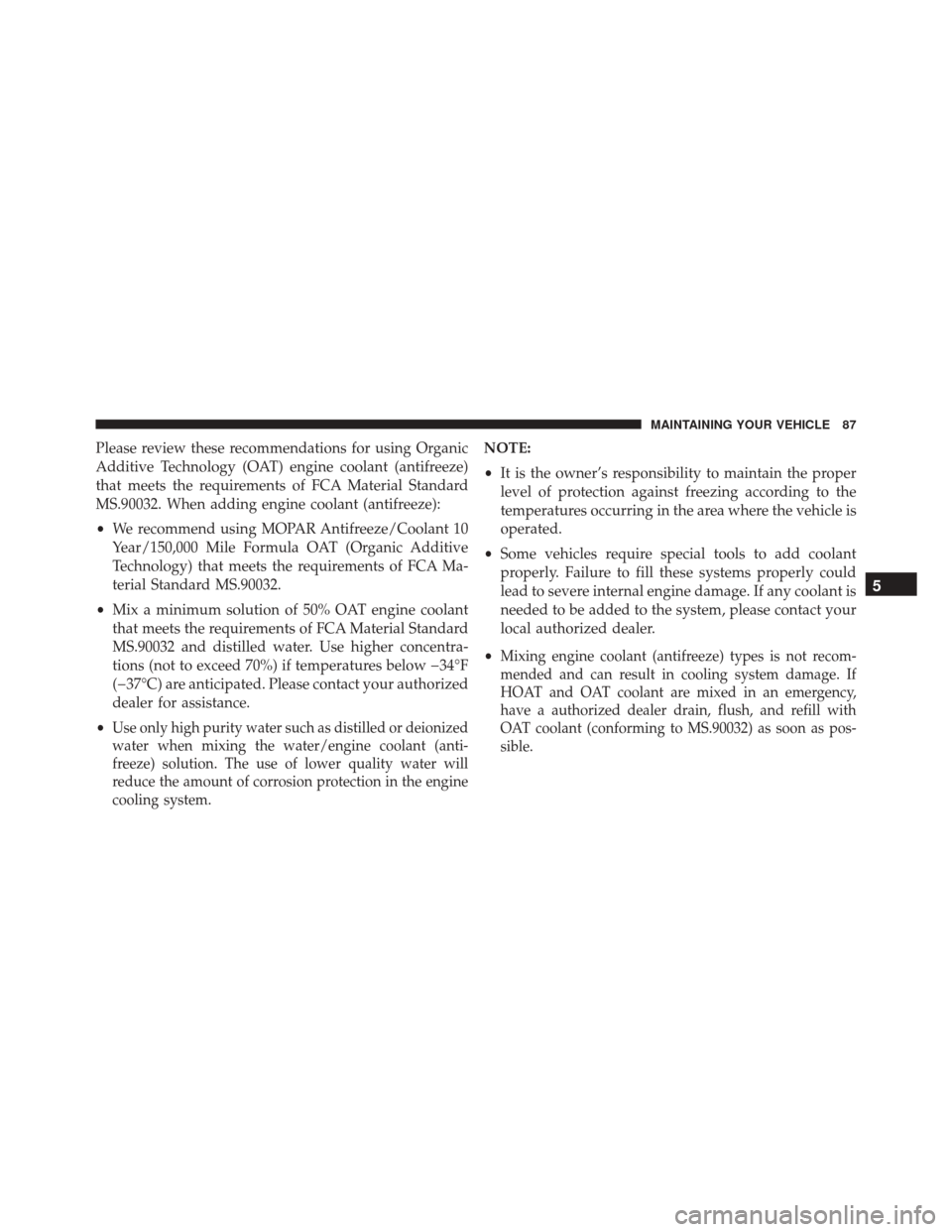
Please review these recommendations for using Organic
Additive Technology (OAT) engine coolant (antifreeze)
that meets the requirements of FCA Material Standard
MS.90032. When adding engine coolant (antifreeze):
•We recommend using MOPAR Antifreeze/Coolant 10
Year/150,000 Mile Formula OAT (Organic Additive
Technology) that meets the requirements of FCA Ma-
terial Standard MS.90032.
• Mix a minimum solution of 50% OAT engine coolant
that meets the requirements of FCA Material Standard
MS.90032 and distilled water. Use higher concentra-
tions (not to exceed 70%) if temperatures below �34°F
(�37°C) are anticipated. Please contact your authorized
dealer for assistance.
•
Use only high purity water such as distilled or deionized
water when mixing the water/engine coolant (anti-
freeze) solution. The use of lower quality water will
reduce the amount of corrosion protection in the engine
cooling system.
NOTE:
• It is the owner’s responsibility to maintain the proper
level of protection against freezing according to the
temperatures occurring in the area where the vehicle is
operated.
• Some vehicles require special tools to add coolant
properly. Failure to fill these systems properly could
lead to severe internal engine damage. If any coolant is
needed to be added to the system, please contact your
local authorized dealer.
•
Mixing engine coolant (antifreeze) types is not recom-
mended and can result in cooling system damage. If
HOAT and OAT coolant are mixed in an emergency,
have a authorized dealer drain, flush, and refill with
OAT coolant (conforming to MS.90032) as soon as pos-
sible.
5
MAINTAINING YOUR VEHICLE 87
Page 101 of 117
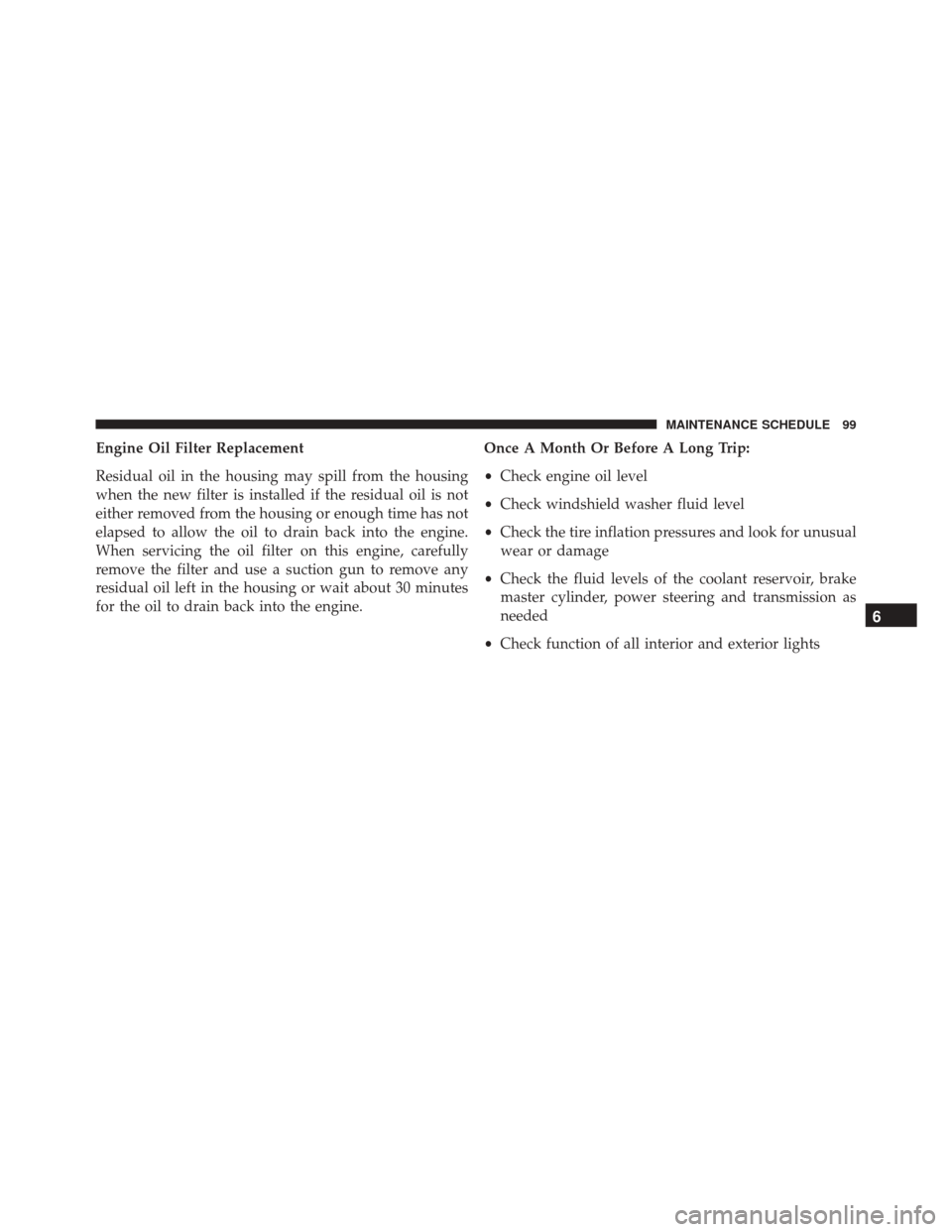
Engine Oil Filter Replacement
Residual oil in the housing may spill from the housing
when the new filter is installed if the residual oil is not
either removed from the housing or enough time has not
elapsed to allow the oil to drain back into the engine.
When servicing the oil filter on this engine, carefully
remove the filter and use a suction gun to remove any
residual oil left in the housing or wait about 30 minutes
for the oil to drain back into the engine.Once A Month Or Before A Long Trip:
•
Check engine oil level
• Check windshield washer fluid level
• Check the tire inflation pressures and look for unusual
wear or damage
• Check the fluid levels of the coolant reservoir, brake
master cylinder, power steering and transmission as
needed
• Check function of all interior and exterior lights
6
MAINTENANCE SCHEDULE 99
Page 110 of 117
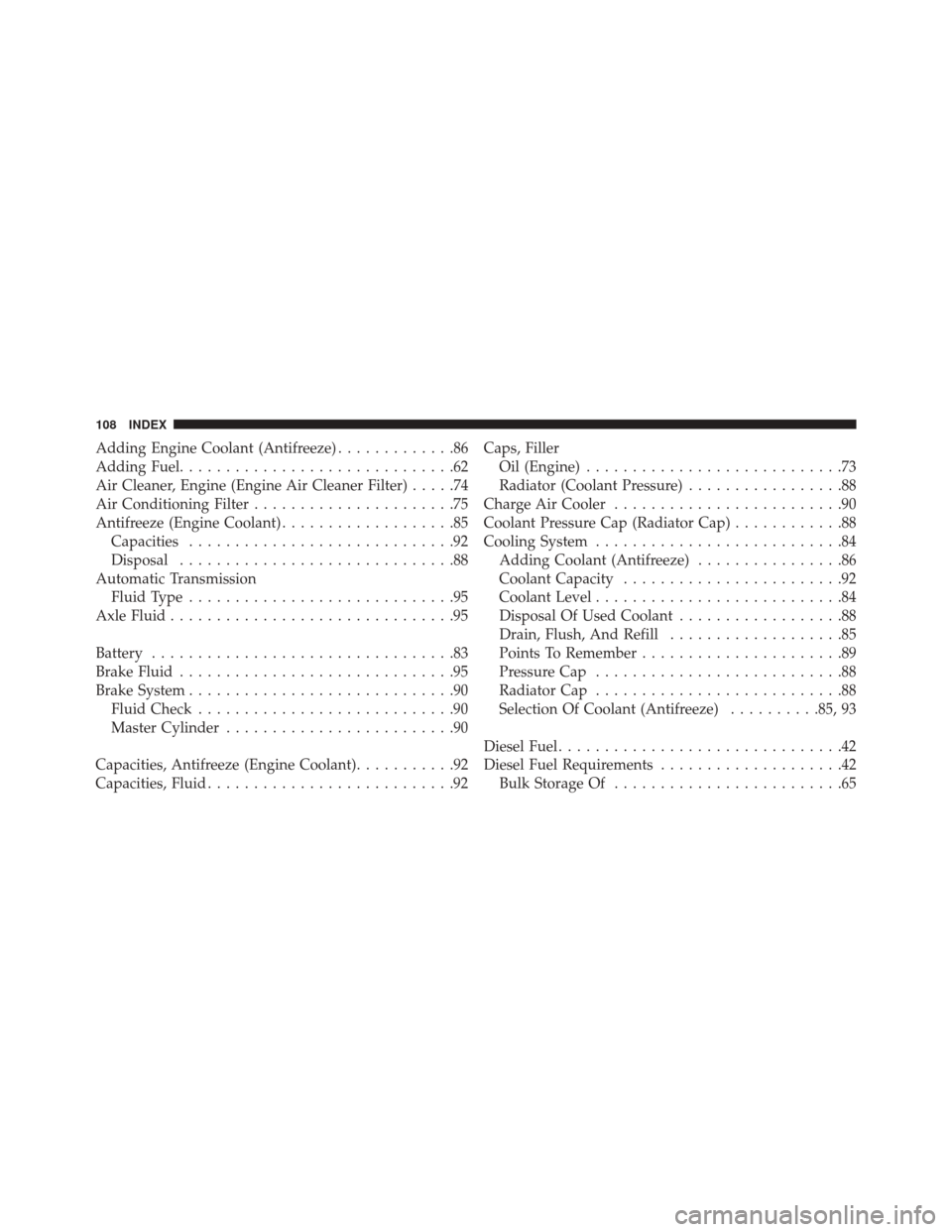
Adding Engine Coolant (Antifreeze).............86
Adding Fuel ..............................62
Air Cleaner, Engine (Engine Air Cleaner Filter) .....74
Air Conditioning Filter ......................75
Antifreeze (Engine Coolant) ...................85
Capacities .............................92
Disposal ..............................88
Automatic Transmission Fluid Type .............................95
Axle Fluid ...............................95
Battery .................................83
Brake Fluid ..............................95
Brake System .............................90
Fluid Check ............................90
Master Cylinder .........................90
Capacities, Antifreeze (Engine Coolant) ...........92
Capacities, Fluid ...........................92 Caps, Filler
Oil (Engine) ............................73
Radiator (Coolant Pressure) .................88
Charge Air Cooler .........................90
Coolant Pressure Cap (Radiator Cap) ............88
Cooling System ...........................84
Adding Coolant (Antifreeze) ................86
Coolant Capacity ........................92
Coolant Level ...........................84
Disposal Of Used Coolant ..................88
Drain, Flush, And Refill ...................85
Points To Remember ......................89
Pressure Cap ...........................88
Radiator Cap ...........................88
Selection Of Coolant (Antifreeze) ..........85, 93
Diesel Fuel ...............................42
Diesel Fuel Requirements ....................42
Bulk Storage Of .........................65
108 INDEX
Page 111 of 117
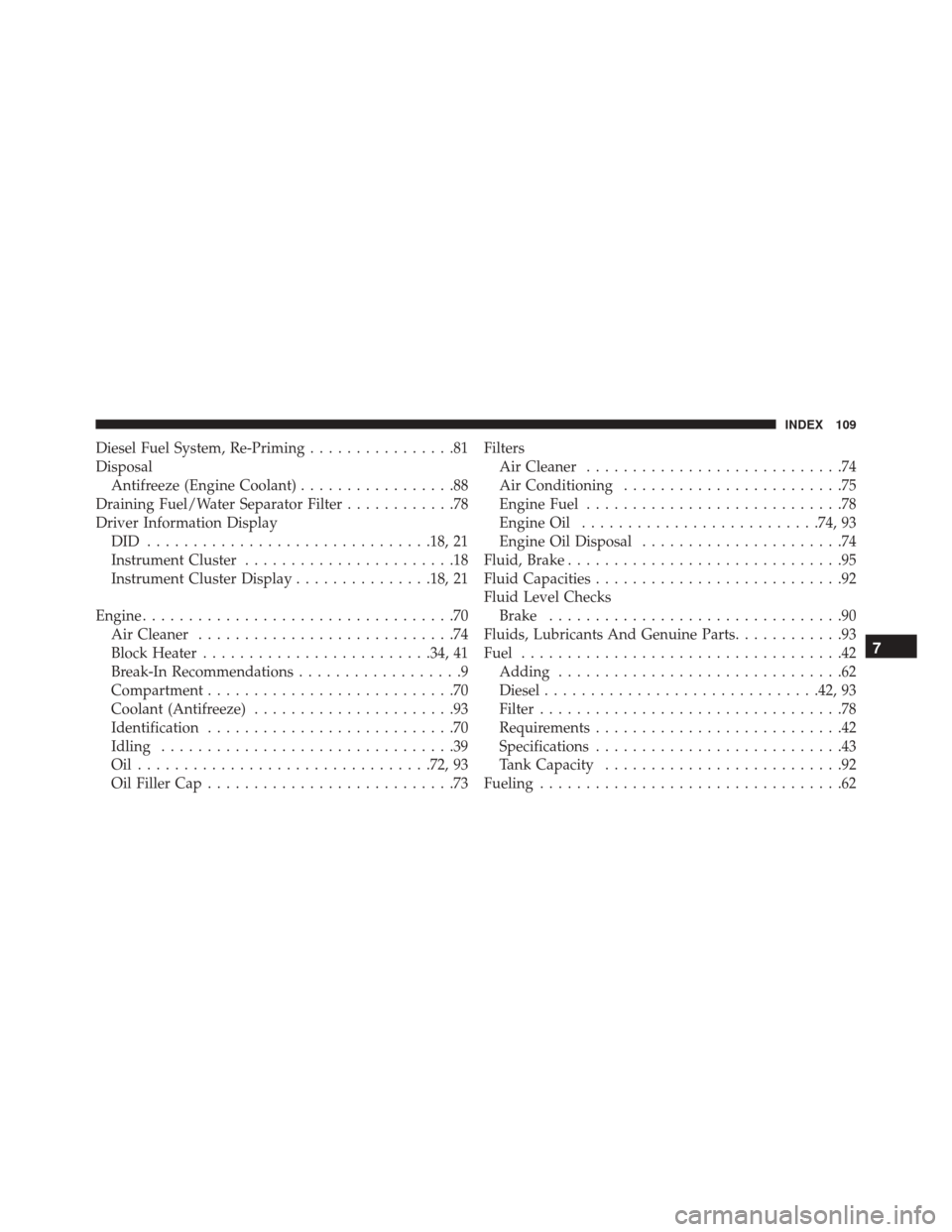
Diesel Fuel System, Re-Priming................81
Disposal Antifreeze (Engine Coolant) .................88
Draining Fuel/Water Separator Filter ............78
Driver Information Display DID .............................. .18, 21
Instrument Cluster .......................18
Instrument Cluster Display ...............18, 21
Engine ..................................70
Air Cleaner ............................74
Block Heater ........................ .34, 41
Break-In Recommendations ..................9
Compartment ...........................70
Coolant (Antifreeze) ......................93
Identification ...........................70
Idling ................................39
Oil............................... .72, 93
Oil Filler Cap ...........................73 Filters
Air Cleaner ............................74
Air Conditioning ........................75
Engine Fuel ............................78
Engine Oil ......................... .74, 93
Engine Oil Disposal ......................74
Fluid, Brake ..............................95
Fluid Capacities ...........................92
Fluid Level Checks Brake ................................90
Fluids, Lubricants And Genuine Parts ............93
Fuel ...................................42
Adding ...............................62
Diesel ............................. .42, 93
Filter .................................78
Requirements ...........................42
Specifications ...........................43
Tank Capacity ..........................92
Fueling .................................62
7
INDEX 109